Exam rooms that shine
This crucial space can set the tone of the entire visit with your clients. Use these tips from veterinary architect Dan Chapel, to keep your space functional and beautiful.
The relationship between veterinarian, client and patient is one of the most critical in veterinary medicine, says veterinary architect Dan Chapel, AIA, NCARB, of Chapel Associates Architects in Little Rock, Arkansas. Most of that relationship is built in the exam room, which is often the farthest point the client comes into your hospital.
While first impressions are built in the reception area, client's opinions of your treatment skills are made in the exam room. An exam room, Chapel says, should be secure and comfortable for both the patient and client. A clean, quiet, odor-free exam room will set the tone for a positive hospital visit.
What are the keys to a perfect exam room experience from a design standpoint? Let's dig in.
How many rooms do you need?
In both new construction and renovation projects, Chapel has noticed a trend toward including more exam rooms in veterinary hospitals. As a rule of thumb, when designing he provides two exam rooms for each doctor working in exam rooms at any given time. This allows for the second exam room to be readied for the next patient while the first is in use.

The exam rooms at McGregor Boulevard Veterinary Clinic in Fort Myers, Florida, have colorful artwork, natural light, comfy seating and treats easily accessible on the exam counter. Photo courtesy of Stuart Gobey, Island Studio Photography.
How do you set up those rooms?
Chapel says that most exam rooms that he designs are “one wall” rooms. This means that the veterinarian's work counter, the exam table and the seating for clients are all along one wall. This configuration often features separate doctor/staff and client/pet entry doors. Laying it out this way also maximizes open space on the floor while keeping exam and treatment materials close at hand. Another benefit of this configuration? The veterinarian never has to turn their back to the client and patient. The work space should also include an easily accessible and secure “sharps” container and trash receptacle.
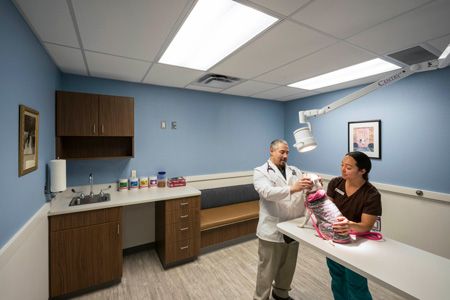
Southwest Veterinary Medical Center in Albuquerque, New Mexico, has a semi "one wall" approach with the work counter and client seating on one wall, across from the exam table. Photo courtesy of Kirk Gittings, Kirk Gittings Photography.
The great sink debate.
With the rise of antibacterial lotions and sprays, to some, actual handwashing when entering an exam room is no longer crucial, though many practitioners still like to have a small bar-sized sink in their exam room for discarding excess liquids or for washing up after an exam. Either way, Chapel does believe that every client should witness the sanitizing of hands prior to the start of any exam or procedure.
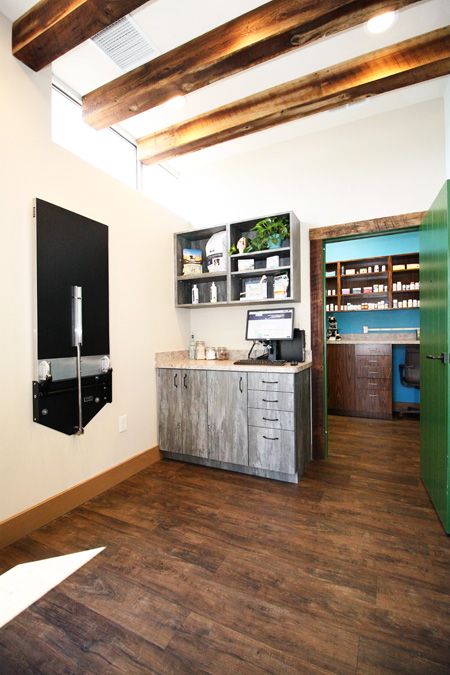
A fold up exam table leaves plenty of space for exams o be done on the floor at Happy Tails Veterinary Care in Bethlehem, Georgia. Photo courtesy of Jennifer Wettstein, Wettstein Photography.
Is your table the right size?
The usability of the exam table should be considered before construction of the exam room takes place, Chapel advises. Generally, the work surface of these tables is approximately 24”x48” to allow for examinations of even large dogs, and they're 36” off of the floor. If a practitioner would rather perform some examinations on the floor, a fold-down exam table can help facilitate those cases. Lift tables can also be helpful in an exam room or two for large patients.
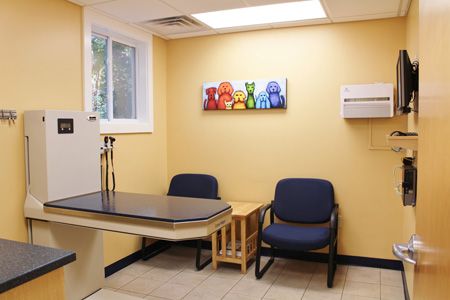
Noank-Mystic Veterinary Hospital in Noank, Connecticut, utilizes a lift table in their canine exam room to help facilitate exams of large dogs. Photo courtesy of Nicholas Kastanek, Erin Mooney.
Give your clients a seat…
Give clients space off of the floor to sit and place their belongings. This can be done either with bench seating, or individual chairs. The seating should be located along the focal wall of the exam room to allow for better face-to-face communication between veterinarian and client.
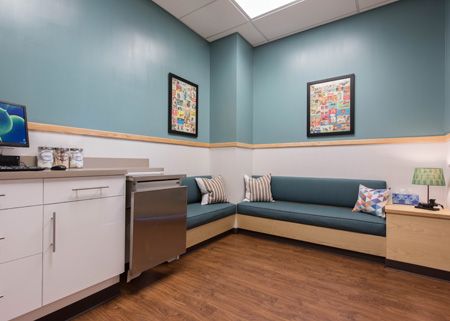
Boulevard Veterinary in Chicago, Illinois, has comfy bench seats for clients to use while in the exam room. Photo courtesy of Aaron Gang, Aaron Gang Photography
And drop some knowledge on ‘em.
The exam room is the perfect place for client education. Facilitate this by adding video monitors that can display educational videos and/or the patient's digital radiographs and chart information, Chapel says. Keep a binder of frequently used client handouts in the room for easy access when you need them. Anatomical models or charts to aid explanations to clients are also useful things to keep in your exam rooms. If you're retail savvy you might think about placing some open shelving for product display, explanation and demonstration in your exam room.
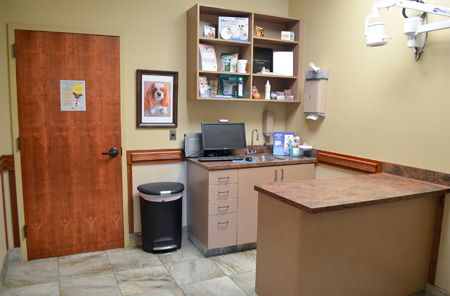
Carolina Ranch Animal Hospital & Resort in Garner, North Carolina, has convenient access to a trash receptacle, as well as open shelving for high-use products or products that clients would often purchase. Photo courtesy of Paul Potera.
Get your chill on.
Placing small refrigerators in your exam rooms gives you quick access to the vaccinations you use frequently without having to leave the room. Chapel notes that the cost of putting these fridges in is small, it decreases staff travel and it may reduce the amount of refrigeration needed in other areas of the hospital.
It's all about the tools.
The equipment placed in each exam room varies from veterinarian to veterinarian, but most these days have storage and enough power for exam lights, a radiograph viewer, an otoscope, an ophthalmoscope and a digital thermometer.
Special use exam rooms
More and more practices are putting in special use or multi-use exam rooms, such as comfort rooms for euthanasia appointments or consultation rooms, Chapel says. Ideally these rooms are a little larger than the typical exam room, have more comfortable seating and have a private exit for clients to use.
Dan Chapel is president of Chapel Associates in Little Rock, Arkansas, a nationally recognized firm specializing in animal facility design. His firm has participated in the design of more than 750 veterinary hospitals, boarding kennels, and animal shelters.